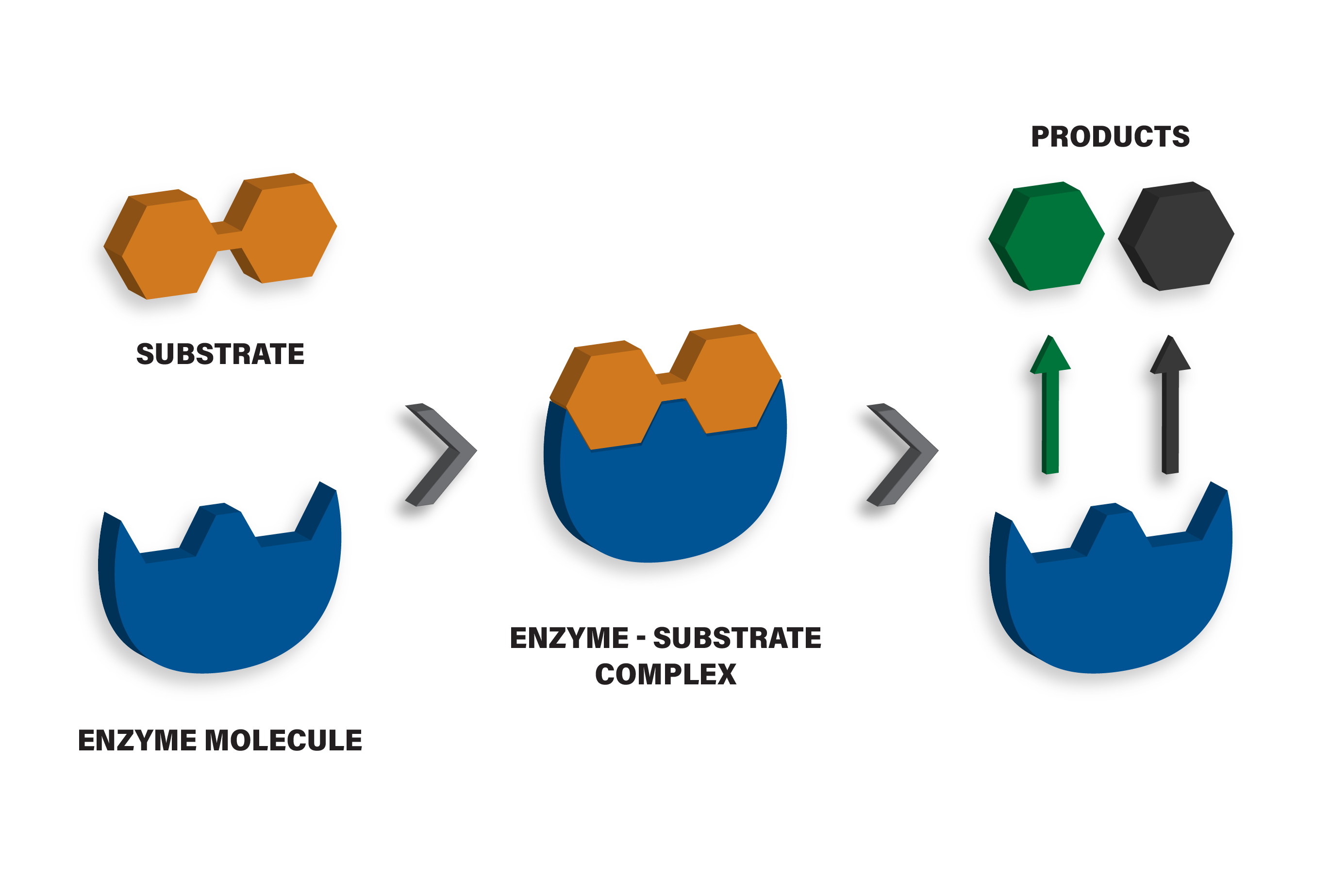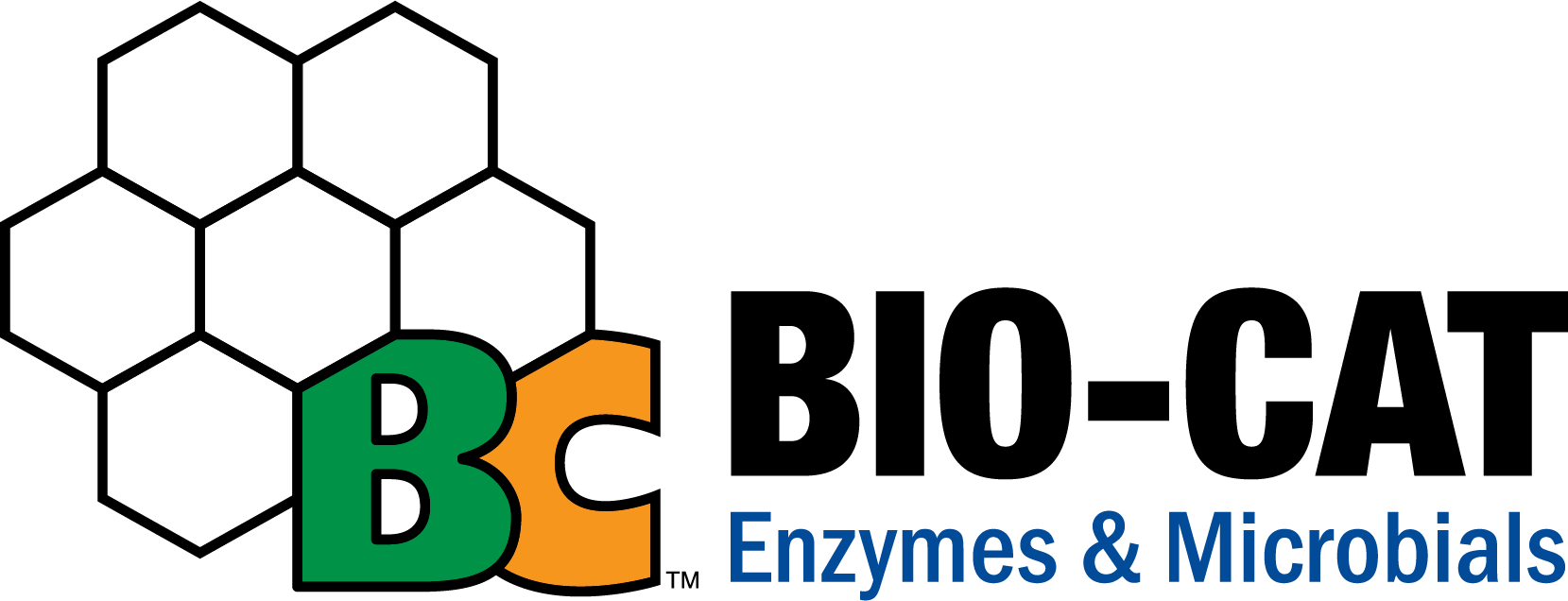The human digestive system facilitates a dynamic and sophisticated response to food. Critical to digestion are enzymes. Our bodies produce our own enzymes in the salivary glands, stomach, pancreas, and small intestine. Supplemental microbe- and plant-based enzyme formulations are designed to complement our own biology.
Introduction to
DIGESTION & ENZYMES
Digestive Enzymes Promote Healthy Digestion and Nutrient Release to Help Comfortably Fuel your Lifestyle.

What are enzymes?
Proteins comprise an essential part of our diet and can also be generated inside every one of our cells. One class of proteins, called enzymes, are critical in every major biochemical process to catalyze, or accelerate, chemical reactions.
There are six main types of enzymes each with different reaction capabilities:
- transferases
- ligases
- oxidoreductases
- isomerases
- lyases
- hydrolases
Digestive enzymes are classified as hydrolases and catalyze reactions by the addition of water to a macronutrient substrate to generate smaller bioactive molecules that are absorbed for cellular nutrition.
Enzymes contain “active sites” where specific target molecules, or substrates, bind and undergo chemical transformation. Macronutrient substrates include proteins, fats, and carbohydrates. Common digestive enzymes that bind with macronutrient substrates include proteases, peptidases, amylases, and lipases.

Why supplement with enzymes?
The human body has several ways to communicate an opportunity for better digestion. Common signs of insufficiently digested food and chyme include flatulence, bloating, occasional indigestion, and undigested food in the stool. Gas is the direct byproduct of bacterial fermentation of under-digested food or under-hydrolyzed chyme, leading to bloating and abdominal discomfort.
Several clinical studies have suggested that oral microbial enzyme supplementation can reduce symptoms associated with occasional indigestion or food intolerances. Common food intolerances include dairy lactose, wheat gluten, histamine, and FODMAPs (fermentable oligo-, di-, mono-saccharides and polyols) such as the complex galacto-oligosaccharide carbohydrates found in beans and nuts.
Supplemental enzymes may also be an approach to support digestive health in older adults, especially those with food intolerances. Advancing age is associated with greater digestive discomfort and distress, as well as decreased digestive enzyme activity. The release of pepsin—the chief protease in the stomach—has been shown to decline with advancing age. Several observational clinical studies have also suggested that pancreatic enzymes critical for digestion show decreased output or activity with older age.
There is also evidence for decreased bicarbonate secretion with age, which could decrease duodenal pH and pancreatic enzyme activity. In contrast to human and porcine enzymes, it is important to note that many microbial, fungal, and plant enzymes can digest macronutrients in both acidic and neutral pH environments. Such microbial enzymes are acid-resistant and can promote digestion across both the stomach and duodenum.
How does digestion work?
The digestive response to food ingestion is led by the stomach, intestine, and pancreas, with some help from the central nervous system.
The process begins with salivary glands in the mouth releasing amylase to initiate the digestion of carbohydrates. In the stomach, food digestion ramps up through acid-mediated hydrolysis and peristaltic contractions. The stomach accelerates protein digestion by the release of an endopeptidase enzyme called pepsin.
Partially digested food, now called chyme, passes into a long, tube-like organ called the small intestine. The inner part of this tube is called the lumen, whereas the wall of the tube contains distinct cells that specialize in mucin secretion, immune surveillance, or further digestion and absorption. A single cell layer called the epithelium separates the lumen from the intestinal wall.
The small intestine is composed of three parts: the duodenum, jejunum, and ileum, in that order. The uppermost and shortest component of the small intestine, the duodenum, specializes in digestion. It is here that bicarbonate is released to neutralize the acidic pH of chyme for optimal activity of digestive enzymes such as endopeptidases and amylase that are secreted by the pancreas. Additionally, bile salts from the liver help emulsify dietary fats to enable effective pancreatic lipase activity.
The duodenum’s “brush border”, or interface of the lumen and the epithelium, comprises additional enzymes that further break down macronutrients. Altogether, more than 20 digestive enzymes are produced across the salivary glands, stomach, pancreas, and small intestine.
The biochemical products of digestion include amino acids from proteins, fatty acids from fats, and monosaccharides from carbohydrates. These nutrients are now readily absorbed by the epithelium along the remaining length of the small intestine that includes the jejunum and ileum. Undigested or unabsorbed components of the chyme, such as certain plant fibers or excess nutrients, pass to the large intestine where they can be fermented and metabolized by gut microbes.
References
Di Stefano M, Miceli E, Gotti S, et al. The effect of oral alpha-galactosidase on intestinal gas production and gas-related symptoms. Dig Dis Sci. 2007;52(1):78-83.
DiPalma JA & Collins MS. Enzyme replacement for lactose malabsorption using a beta-D-galactosidase. J Clin Gastroenterol. 1989;11(3):290-293.
Feldman M, Cryer B, McArthur KE, et al. Effects of aging and gastritis on gastric acid and pepsin secretion in humans: a prospective study. Gastroenterology. 1996;110:1043–1052.
Feldman M & Cryer B. Effects of age on gastric alkaline and nonparietal fluid secretion in humans. Gerontology. 1998;44(4):222-227.
Ganiats TG, Norcross WA, Halverson AL, et al. Does Beano prevent gas? A double-blind crossover study of oral alpha-galactosidase to treat dietary oligosaccharide intolerance. J Fam Pract. 1994;39(5):441-445.
Ishibashi T, Matsumoto S, Harada H, et al. Aging and exocrine pancreatic function evaluated by the recently standardized secretin test. Japanese J Geriatr. 1991;28(5):599-605.
Keller J & Layer P. Human pancreatic exocrine response to nutrients in health and disease. Gut. 2005;54(Suppl 6);vi1-vi28.
Kumar VV, Sudha KM, Bennur S, et al. A prospective, randomized, open-label, placebo-controlled comparative study of Bacillus coagulans GBI-30,6086 with digestive enzymes in improving indigestion in geriatric population. J Family Med Prim Care. 2020 Feb 28;9(2):1108-1112.
Laugier R, Bernard JP, Berthezene P, et al. Changes in pancreatic exocrine secretion with age: pancreatic exocrine secretion does decrease in the elderly. Digestion. 1991;50:202–211.
Majeed M, Majeed S, Nagabhushanam K, et al. Evaluation of the safety and efficacy of a multienzyme complex in patients with functional dyspepsia: a randomized, double-blind, placebo-controlled study. J Med Food. 2018;21(11):1120-1128.
Mego M, Accarino A, Malagelada JR, et. al. Accumulative effect of food residues on intestinal gas production. Neurogastroenterol Motil. 2015;27(11):1621-1628.
Montalto M, Nucera G, Santoro L, et al. Effect of exogenous beta-galactosidase in patients with lactose malabsorption and intolerance: a crossover double-blind placebo-controlled study. Eur J Clin Nutr. 2005;59(4):489-493.
Rémond D, Shahar DR, Gille D, et al. Understanding the gastrointestinal tract of the elderly to develop dietary solutions that prevent malnutrition. Oncotarget. 2015;6(16):13858-13898.
Tuck CJ, Biesiekierski JR, Schmid-Grendelmeier P, et al. Food Intolerances. Nutrients. 2019;11:1684.
Vellas B, Balas D, Moreau J, et al. Exocrine pancreatic secretion in the elderly. Int J Pancreatol. 1988;3(6):497-502.
Learn About Our Services
Let’s Develop Something Together
We’re as passionate as you are about scientific innovation that matters
Learn More
